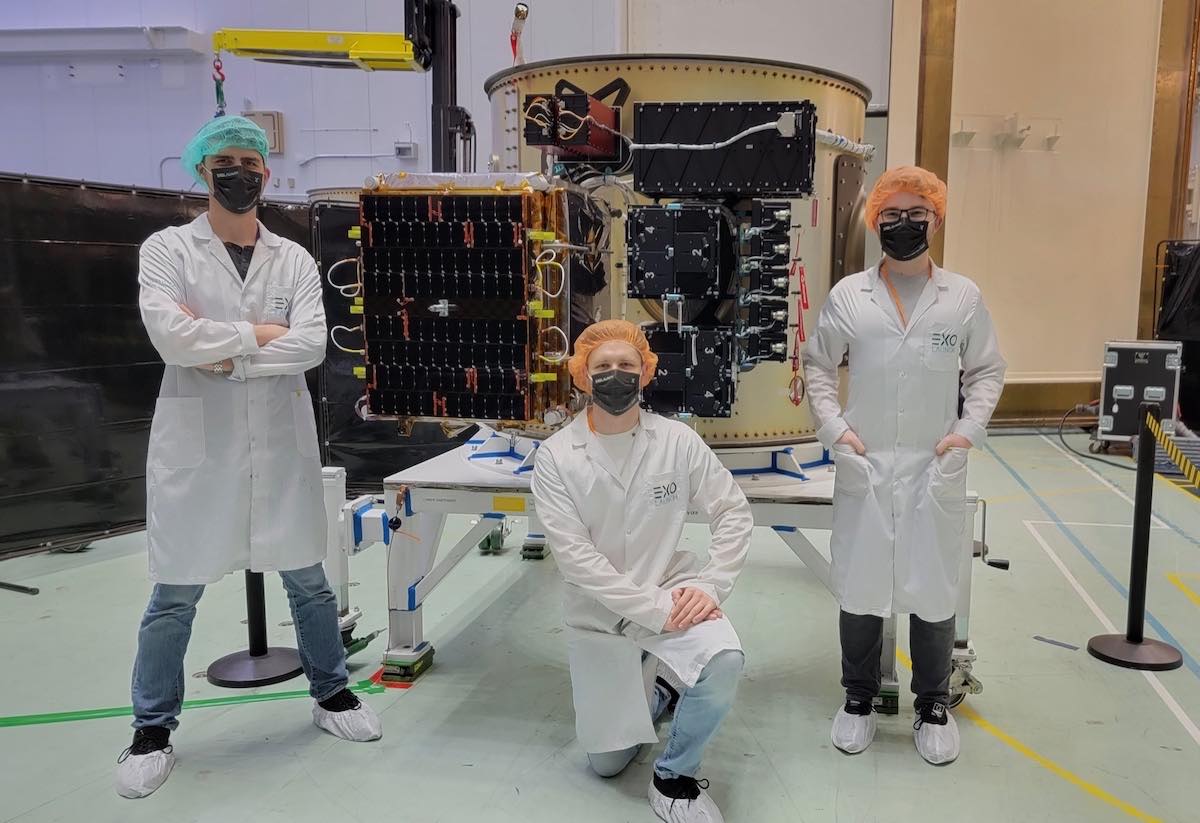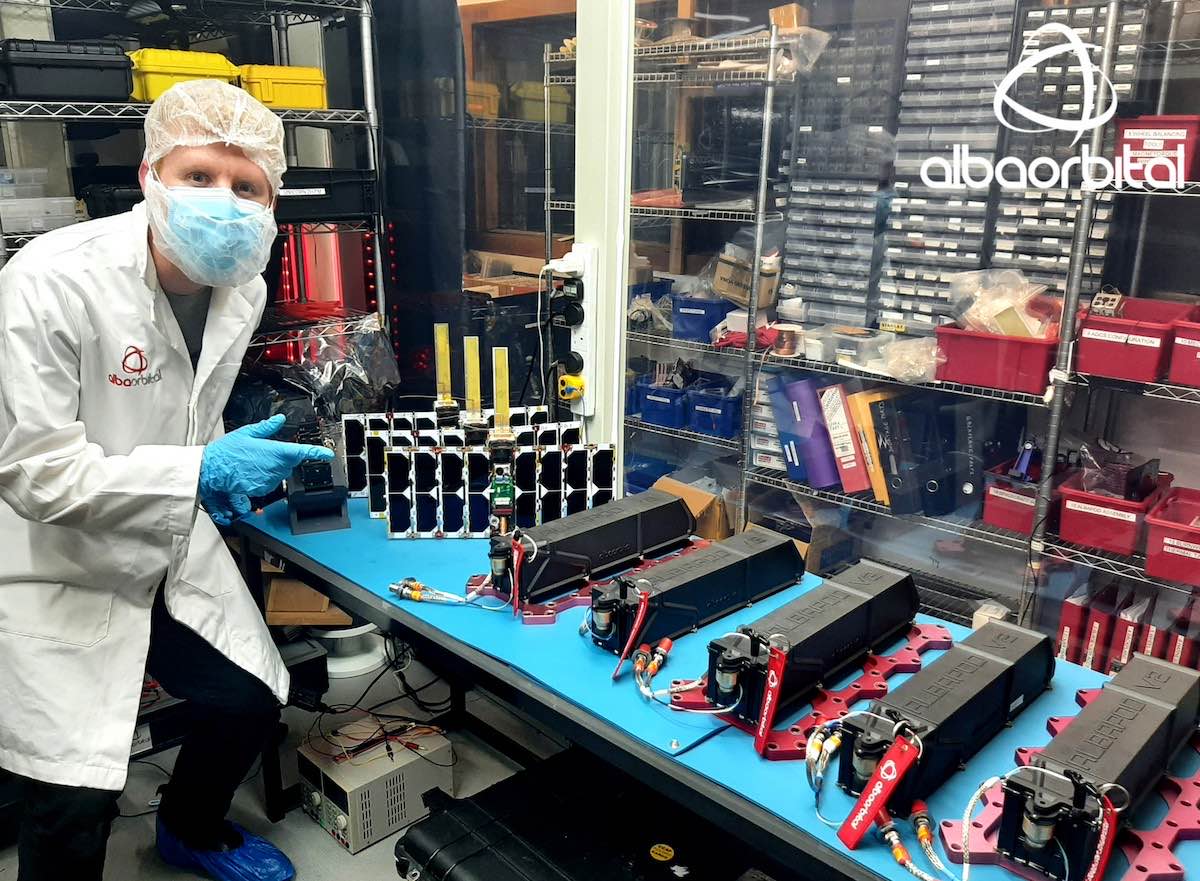
SpaceX launched 105 small satellites from Cape Canaveral on the company’s third Transporter rideshare mission Thursday, deploying payloads for commercial remote sensing companies, communications and data relay startups, and foreign governments.
Eight-and-a-half minutes after launch, the rocket’s first stage booster made a return to the Florida spaceport, nailing a propulsive landing at Cape Canaveral Space Force Station accompanied by a crackling double sonic boom.
The successful launch was SpaceX’s second Falcon 9 rocket flight this year.
The mission began with a fiery blastoff from pad 40 at Cape Canaveral at 10:25:39 a.m. EST (1525:39 GMT) Thursday. Nine Merlin 1D engines, combining to generate 1.7 million pounds of thrust, powered the 229-foot-tall (70-meter) launcher into a crystal clear sky.
Heading downrange to the south-southeast, the rocket surpassed the speed of sound and then shed its first stage section nearly two-and-a-half minutes into the flight. An upper stage engine took over the flight as the booster stage pulsed cold gas nitrogen-fed thrusters to flip around and fire three of its Merlin powerplants to reverse course and return to Cape Canaveral.
Thanks to clear skies, the aerobatic flip maneuver and boost-back burn were spectacularly visible to observers on the ground. The rocket’s dueling exhaust plumes created a cloud of vapor high up in the mid-morning sky.
The upper stage continued into orbit with a six-minute burn of its Merlin engine, flying a course parallel to Florida’s east coast, then over Cuba and the Caribbean Sea. The rocket jettisoned its clamshell-like payload fairing during the orbit insertion burn, while the first stage arced to an apogee, or high point, of about 87 miles (141 kilometers) before beginning its descent back to Earth.
An entry burn helped slow the booster’s plunge, and finally a single engine lit for a final braking maneuver as the rocket unfurled its landing gear to settle for a helicopter-like precision vertical touchdown at Landing Zone 1, around 9 miles (13 kilometers) south of the mission’s liftoff location.
The landing capped the 10th trip to space for SpaceX Booster No. 1058, which debuted in May 2020 with the company’s first flight with astronauts — NASA’s Crew Dragon Demo-2 test flight — to the International Space Station.

The upper stage shut off its engine just as the booster stage landed, beginning a coast halfway around the world, soaring over Antarctica and then heading northbound over the Indian Ocean.
A brief two-second restart of the upper stage engine placed the rocket at the correct altitude and inclination for deployment of the mission’s 105 payloads. The mission started separating its payloads at an altitude of 333 miles (536 kilometers) in a polar orbit.
The half-hour deployment sequence included separation of 99 individual satellites from the Falcon 9’s payload stack. Another six satellites were mounted to a carrier spacecraft that will release its passengers later.
The mission Thursday, known as Transporter 3, followed SpaceX’s first two Transporter rideshare flights in 2022.
SpaceX announced its small satellite rideshare launch service in 2019. SpaceX intends to launch as many as four dedicated ridehsare flights on Falcon 9 rockets this year, doubling the rate of Transporter launches from about one every six months to one every three-to-four months.
There’s high demand for the rideshare launch service. Several SpaceX customers have said the price for a slot on a Transporter mission is unmatched in the launch industry.
On its website, SpaceX says it charges customers as little as $1 million to launch a payload of 440 pounds (200 kilograms) on a dedicated rideshare flight to sun-synchronous orbit. The price is enabled by cost reductions from reusing Falcon 9 rocket hardware.
Companies like Berlin-based Exolaunch, the Italian launch broker D-Orbit, and Spaceflight in Seattle reserved ports on the Transporter 3 payload stack, then divided that capacity among multiple small satellite customers.
D-Orbit had its own satellite carrier mounted on the Transporter 3 payload stack. The company’s ION SCV004 vehicle separated from the Falcon 9 rocket to later release its own satellite passengers.
The payloads on-board the Transporter 3 mission ranged from smaller than a soda can to the size of a washing machine.
The biggest of the group was the Ukrainian Sich 2-1 satellite, a 375-pound (170-kilogram) government-funded Earth-imaging spacecraft delayed for years by political and economic turmoil in Ukraine, largely driven by the country’s conflict with Russia.
The Sich 2-1 satellite, also named Sich 2-30, was built by the Ukrainian company Yuzhnoye. It hosts a medium-resolution imaging payload to take pictures of Earth’s surface in visible and near-infrared wavelengths, collecting data useful in urban planning, crop management, and environmental monitoring.
Radar remote sensing satellites were also part of the Transporter 3 payload package.
Two satellites reach for Finland’s ICEYE and the U.S. company Capella were stowed inside the Falcon 9 rocket’s payload shroud. Both companies are building out fleets of small satellites using radar beams to regularly map the world’s land masses, oceans, and ice sheets.

Radar imaging doesn’t provide as much color or detail as optical remote sensing, but radar satellites come with the benefit of being sensitive day or night, and in all weather conditions.
Images from ICEYE and Capella are sharp enough for analysts to pick out ships, buildings, and other features on Earth’s surface smaller than 1 meter (3 feet) in size.
ICEYE’s two new satellites joined 13 others already in the company’s constellation. Each satellite weighs about 187 pounds (85 kilograms), and carries a radar antenna that will unfold once it’s in orbit.
Capella, a competitor to ICEYE, also added two satellites to its fleet with the Transporter 3 mission. The new additions, each about 220 pounds (100 kilograms) at launch, join five satellites already in Capella’s commercial fleet providing radar imagery to the U.S. military and other customers.
Another radar remote sensing company, Umbra, also had a satellite on-board the Transporter 3 mission. Umbra’s second satellite follows a first spacecraft launched on Transporter 2 last year.
Like the ICEYE and Capella satellites, the 143-pound (65-kilogram) Umbra satellite will unfurl a radar antenna after separating from the Falcon 9 rocket. Umbra is also building out a fleet of satellites, which it says will be capable of capturing the highest-resolution radar images of any commercial constellation at just 6 inches (15 centimeters).
Falcon 9 landing confirmed!
Accompanied by sonic booms, the 15-story booster, designated B1058 in SpaceX’s fleet, has completed its 10th trip to space and back since debuting in May 2020 on the company’s first astronaut mission.https://t.co/XoYMSnB4Ln pic.twitter.com/EXWcFYVby8
— Spaceflight Now (@SpaceflightNow) January 13, 2022
The Transporter 3 mission also hauled 44 small SuperDove optical imaging satellites into orbit for Planet, which owns the industry’s largest fleet of Earth observation spacecraft. The San Francisco-based company said before the launch it would have more than 240 satellites in orbit with the new flock of SuperDoves that took off Thursday.
The SuperDove satellites are about the size of a shoebox, and they form the backbone of Planet’s constellation mapping all of Earth’s land masses every day. “This unprecedented capability provides our customers with daily data about Earth resources and global events,” the company said in an update posted on its website.”
The Transporter 3 mission was the first for Planet and SpaceX under a new multi-launch agreement signed last year, cinching SpaceX’s position as Planet’s “go-to launch provider” through the end of 2025.
Other satellites on the Transporter 3 launch included eight “Tevel” CubeSats built by students in Israel. Led by the Herzliya Science Center, the Tevel satellites will support amateur radio communications in low Earth orbit.
There were five small CubeSats on the mission for Spire Global, which operates a constellation of smallsats collecting weather and ship tracking data. Four CubeSats were on-board for Kepler Communications, a Canadian company deploying a data relay satellite network.
Three MDASat nanosatellites from South Africa also launched on the Transporter 3 mission. They are part of a nearly $2 million government-backed project to detect, locate, and track maritime traffic near South African coastal zones.

Other companies with satellites on the Transporter 3 mission included Sen, a British firm launching its first CubeSat spacecraft in a planned fleet to provide high-definition video of Earth. There was also a CubeSat from the Norwegian University of Science and Technology, which intends to use a color-sensitive hyperspectral imager to monitor oceans.
Lunasonde, a company based in Tucson, Arizona, launched the first satellite in its planned Gossamer constellation designed for subsurface imaging, with the ability to help locate underground water, mineral deposits, and other resources.
SpaceX’s Transporter 3 launch also carried a small satellite from the French startup UnSeenLabs, which is in the maritime surveillance business. A CubeSat from Dubai launched to help officials monitor and manage the city’s electricity and water networks,
A CubeSat named NuX 1, owned by NuSpace in Singapore, will demonstrate data relay technologies and a lower-power Hall effect thruster. A CubeSat from Taiwan, named IRIS A, has a similar communications tech demo purpose.
Another spacecraft deployed from the Falcon 9 rocket is the ION SCV004 CubeSat carrier, owned by the Italian company D-orbit, which itself will release six nanosatellites after separating from the rocket. The payloads on D-Orbit’s carrier include four CubeSats from the Polish company SatRevolution and the VZLUSat 2 technology demonstration satellite from the Czech Aerospace Research Center.

A CubeSat payload from the University of Southern California, named Dodona, was also be packed onto D-Orbit’s ION satellite carrier.
The Dodona satellite carries instrumentation and software for Lockheed Martin’s La Jument mission, which will help spacecraft designers mature artificial intelligence and machine learning technologies.
The instruments on-board include optical and infrared cameras, a soft-defined payload to demonstrate on-orbit cyber threat detection capabilities, and an app to allow the satellite’s computer to automatically enhance the quality of an image, Lockheed Martin said.
The smallest satellites launched on the Transporter 3 mission were so-called PocketQubes, tiny satellites that weigh between 1 and 2 pounds.
According to a tally of the payloads provided by SpaceX and mission customers, there were 21 PocketQubes on the Transporter 3 launch for customers in Spain, the United Kingdom, the Netherlands, Turkey, Argentina, Brazil, Nepal, and the United States.
Their missions range from education and training of future engineers, to technology testing, communications, and remote sensing.

Some of satellites assigned to the Transporter 3 launch were pulled off the mission after a Sherpa space tug, supplied by the rideshare launch broker Spaceflight, suffered a propellant leak during pre-flight processing at Cape Canaveral in December.
The Sherpa tug was removed from the Transporter 3 payload stack, and the satellites it was supposed to deploy will be reassigned to other missions, Spaceflight said.
One of the affected CubeSats, VZLUSat 2 from the Czech Republic, was able to be reconfigured for a ride on the D-Orbit deployer on the same Transporter 3 launch.
Email the author.
Follow Stephen Clark on Twitter: @StephenClark1.
from Spaceflight Now https://ift.tt/3fIzQzj
via World Space Info







0 comments:
Post a Comment